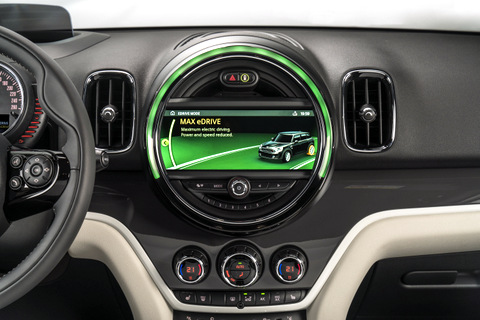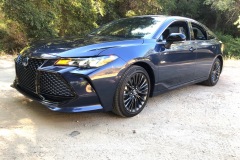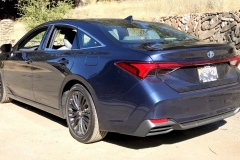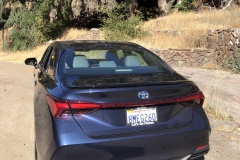A Toe in the EV Water
The Countryman is the largest of the four Mini models and is also the brand’s only all-wheel drive offering. Now, it’s also Mini’s first electrified model sold to consumers. It received major changes for its second generation, which was introduced in stages last year.
While Mini’s EV excitement is focused on the upcoming all-electric small hatchback, the 2018 Mini Countryman Plug-in Hybrid offers a taste of electrification to urban folks. They’ll find what plug-in hybrids (PHEVs) are known for—electric commuting during the week and unlimited travel on the weekends. That’s better than a regular hybrid, which has no plug, and combines a gasoline engine and electric motor to improve fuel mileage ratings.

PHEVs offer varying amounts of battery power. The Countryman’s 7.6-kWh lithium-ion battery, which hides under the rear seat, provides an EPA-rated 12 miles of all-electric range. That’s low on the list, as most other PHEVs offer EV ranges from the teens and twenties to as much as 53 miles in the Chevrolet Volt. That makes a difference on how much pure electric driving you can do.
Almost All the Way to Work
My Melting Silver Metallic test car, for example, got me about two-thirds of the way to/from work before the petrol began to flow. I dutifully plugged in at each end, and fully charged the small battery overnight on 120-volt current at home or by lunchtime on the 240-volt Level 2 ChargePoint chargers at work.
The Countryman cleverly delivers all-wheel drive by placing a 134-horsepower 1.5-liter gas engine up front, driving the front axles, and an 87-horsepower electric motor in back, driving the rear ones. The total system horsepower is 221, and 284 pounds-feet of torque, enough to send the Countryman from 0-60 in a satisfying 6.8 seconds. The system switches back and

forth based on road conditions to provide extra traction when needed.
Naturally, how you drive determines how long your battery power will last. You can also use three different settings to configure how it’s used. In AUTO eDRIVE, you get pure electric driving up to 55 mph, and the gas engine kicks in when needed (or when the battery is depleted). In MAX eDRIVE, you can drive in pure electric mode up to 78 mph (illegally), with the engine dropping in only if you exceed that. The SAVE BATTERY mode uses the engine only, keeping the battery charged above 90 percent for use later, for example, in town after a long freeway trip, where the EV mode is most effective.
Like most PHEVs, the 2018 Mini Countryman’s instrument panel provides some feedback on energy use and regeneration. A gauge on the left has a Power section, when the energy is flowing out of the battery, and a Charge section below it for when coasting or braking is generating power. The eBoost area of the dial shows when the motor is working with the engine for maximum performance.
The Numbers Are Good
The EPA gives the 2018 Mini Countryman Plug-in Hybrid ALL4 ratings of 65 MPGe for Electricity + Gasoline, and 27 mpg for when it’s using gas only. I averaged 35.5 mpg during my test week.
The Countryman is just slightly bigger than the new Clubman, making it the largest Mini ever (a Maxi?) The main differences between the two big Minis are the Countryman’s all-wheel-drive capability, and its 4.6-inch taller stance.

The new Countryman is also larger than its predecessor. It’s 8.1 inches longer on a 2.9-inch longer wheelbase, which translates into substantially increased rear legroom. It’s 1.3 inches wider, which adds up to two inches of shoulder room. Despite these increases, the car is still relatively compact, although the efficient space utilization makes it technically a midsize car per the EPA.
Since the brand re-emerged in the US in 2002 with its all-new Cooper hardtop (hatchback), it has appealed to people looking for motoring joy with a side of quirkiness. The large central dash display now holds audio and other information rather than the speedometer, but it has colors that react to settings changes. It still features toggle switches for windows and even the ignition.
The Final Numbers
The Countryman is assembled in Born, Netherlands, and contains half German parts (thanks to its BMW parent company), including its engine. The six-speed automatic transmission is Japanese.
My test car, with several options, including the $500 paint color, came to an even $40,000, including destination charges. The base price is $36,800.
The 2018 Mini Countryman Plug-in Hybrid will surely win over its traditional audience—stylish urban folks who want a slightly taller and roomier crossover vehicle with the Mini charms—and a small nod towards environmentalism. The EPA assigns the car just a 3 for Smog, but a commendable 8 for Greenhouse Gas. If you have a 10-mile commute, you could be driving the Mini as an EV all week.
Related Stories You Might Enjoy: More Plug-in Hybrid Options
News: Nissan IMx Electric CUV one of Eight New EVs
News: 2019 Ford Fusion Energi Gains EV Range & Safety Tech
News: Ford Does the Electric Slide
Road Test: 2018 Kia Niro Plug-in Hybrid
Road Test: 2018 Honda Clarity Plug-in Hybrid
Road Test: 2017 BMW i3 Electric
Flash Drive: 2018 Hyundai Ioniq PHEV
Road Test: 2017 Toyota Prius Prime
Disclosure:
Clean Fleet Report is loaned free test vehicles from automakers to evaluate, typically for a week at a time. Our road tests are based on this one-week drive of a new vehicle. Because of this we don’t address issues such as long-term reliability or total cost of ownership. In addition, we are often invited to manufacturer events highlighting new vehicles or technology. As part of these events we may be offered free transportation, lodging or meals. We do our best to present our unvarnished evaluations of vehicles and news irrespective of these inducements.
Our focus is on vehicles that offer the best fuel economy in their class, which leads us to emphasize electric cars, plug-in hybrids, hybrids and diesels. We also feature those efficient gas-powered vehicles that are among the top mpg vehicles in their class. In addition, we aim to offer reviews and news on advanced technology and the alternative fuel vehicle market. We welcome any feedback from vehicle owners and are dedicated to providing a forum for alternative viewpoints. Please let us know your views at publisher@cleanfleetreport.com.







6 thoughts on “Road test: 2018 Mini Countryman Plug-in Hybrid”